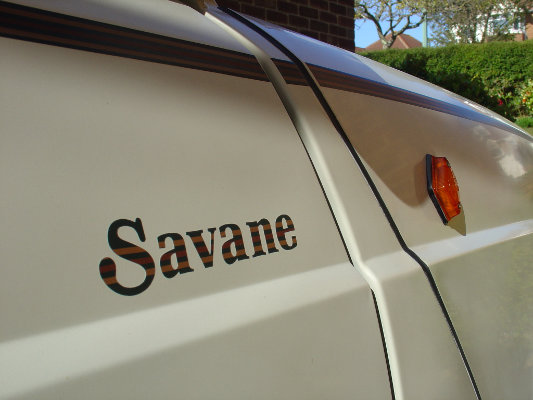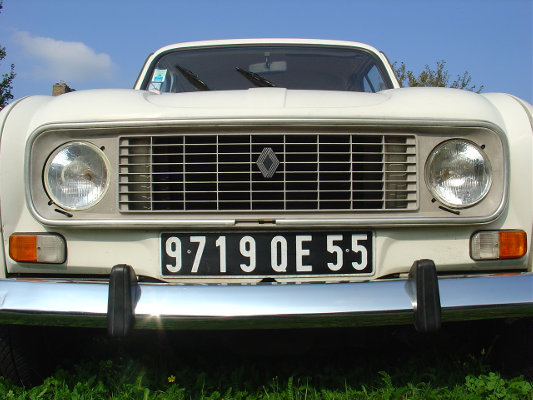
Following on from the brief, teasing introduction given in the previous entry, I now unveil my fourth Four in all its glory. After my purchase of the car at the beginning of September 2009, I had to wait another three weeks for various paperwork and formalities to be completed before I could drive the vehicle or keep it legally on the British roads. This is because, as can now be seen from the photos immediately above and below, this Renault 4 is unlike my previous three in not being originally destined for the UK's shores. It is a French model, which I believe to have been built at the legendary Billancourt factory on the Île Seguin, Paris, if some suggestions contained in its accompanying original French handbook are to be taken at face value.
As for how and why I happened across and obtained this French model in preference over another right-hand drive UK alternative, it was merely a matter of coincidence and timing. In the last entry, I described how my third car, Reflexia, had failed her MOT on a number of issues, but potentially had other problems with the bodywork and mechanics to attend to in the near future. The likely cost in both money, and more importantly my time, of performing all these later repairs might build up to an undesirable level. Much as I am keen to avoid seeing any Renault 4 - particularly an increasingly rare right-hand drive model - go to waste, I have to take a realistic and pragmatic view in consideration of any other possible courses of action. Derek at the Renospeed garage - where my Reflexia was temporarily residing - had come by a French R4 and was keeping it in reserve for a potential buyer. Upon weighing up all its attributes and my future needs of spending more time in France, I took the plunge (financially at least) and steered towards a new affair with a foreign Four.
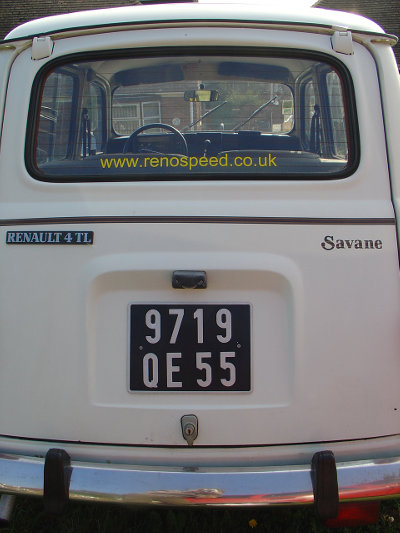
So, you'll likely be wondering in frustration at my round-the-houses waffle, just what are the facts and features of this new French family member? And most importantly of all, what have I named it? That's surely the bit you're all waiting for. The scan of its most recent French Certificat d'immatriculation (below) provides some hints. Unfortunately, I had to cede ownership of the document during the import process, and so I now have no other official papers from the car in its former French life, except for a document of sale from a previous owner to a buyer with a British address in late 2006.
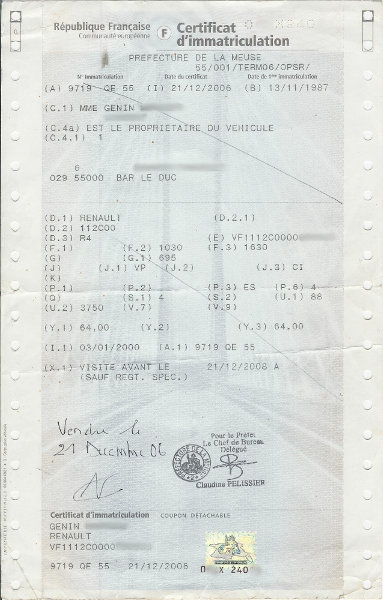
I have decided, after much frivolous pontification, to designate the car a full title of 'Desert Queen Geanine Hoefling de la Meuse'. But you can call it 'Queen Geanine', for short. To deconstruct this lavishly long name with the tedious examination it surely deserves, I shall first cite a few more details about the car. It is a 1987 TL Savane, a variant that I believe never appeared in Britain but which is merely a light rebranding of the TL generation of Renault 4s, the production of which continued - perhaps surprisingly - alongside the more powerful GTL models right up until the early nineties when the final Fours were thrust upon the world. Whilst the TL was denoted as a Savane in some markets, the GTLs were given the suffix of 'Clan'. There were some countries where neither of these monikers were adopted and the R4 came in standard varieties, in addition to a few special editions over its latter years, such as the Cartes Jeunes or Bye Bye. Britain never even saw any new models imported beyond 1986, so the Savane is a particularly uncommon sight here.
With Savane simply meaning Savannah in English, this lends the vehicles something of the desert to their character, and whilst a desert environment is less green and lush than a savannah, there is something undeniably dusty about the colour schemes Renault chose to represent the Savane concept; white, grey, beige, dusky blue and so forth, with interior furnishings to suit. The Clan, meanwhile, was awarded something resembling Scots Highland tartan in its upholstery, and had a selection of paintwork options in such hues as vibrant reds and blues. I had never really been that enthralled by the Savane version in part due to its dowdy colours, but I now begin to appreciate a certain understated elegance, having observed all the finishing touches in finer detail than ever before. Aside from the multi-tone brown decals, however, there is little to differentiate this series from any regular TL.
My choice of the 'Desert' prefix was not only influenced by the savannah, but also by a Renault 4 website I recall viewing around the turn of the millennium, and now long since vanished. The site detailed the tales of a participant in the 4L Trophy or some other such aid mission to the Moroccan desert, and both the car and the site itself were entitled 'Desert Queen'. In following my tradition of creating a name out of the letters on the number plate, I faced a dilemna on this occasion. The original French plates included just two letters, 'QE', but I knew that in re-registering the car in the UK I would be awarded some other string of characters. Shunning the obvious and overly patriotic option of Queen Elizabeth, I derived just the Queen element instead. Look closely at the French registration certificate and you'll see a former owner listed as having the name 'Genin'. This is the family portion of their name, but I adapted it with an English twist and turned it into the first name Jeanine, only the less common variant beginning with a G.
Once the British registration arrived, I was somewhat dismayed at the lousy and uninspiring string of 'HFG' with which to work. In keeping with the exacting demands of all my previous three R4s, my task was to find a name that must begin with H, and feature the F and G in consecutive order. Since I already had a first name in Geanine, hunting down a hatful of H's for surnames turned up a minimal selection of delights such as Hufnagel. In conjunction with the final name in the set, I settled upon Hoefling as a more suitable family tree to associate with this Queen. The last two digits on French number plates up until recently were always symbolic of the département in which the vehicle was registered. In this case, 55 represents the 'Meuse', an area in the north-east of France bordering on Belgium and close to Luxembourg. Given these faintly Germanic geographical leanings, I attributed the Hoefling dynasty as a fitting backdrop to the car's heraldry, and rounded it all off with the département itself. So now you know, but probably wish you didn't.
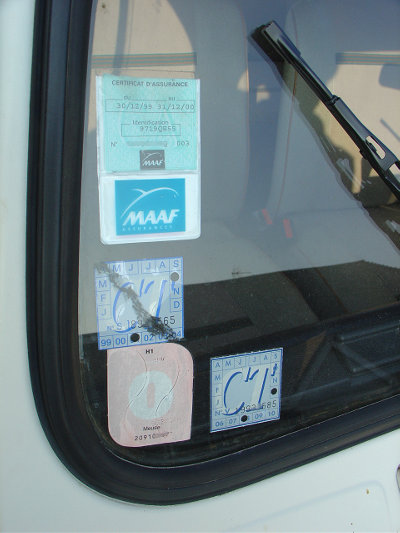
Exactly what happened to the car in all its former years is unclear, especially the part from 2000 onwards when the last declaration of insurance was placed in its windscreen (above). As with all my cars, I shall be interested to hear from anybody with information on its history.
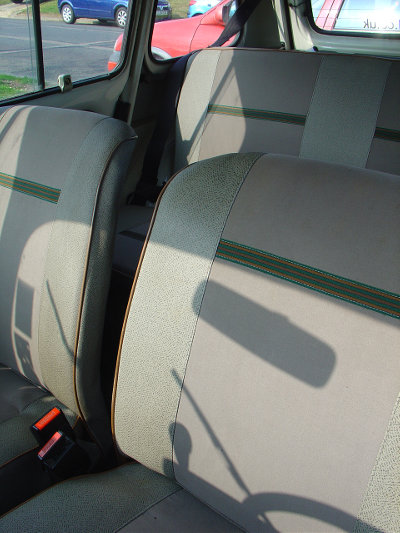
My Queen Geanine is of course a left-hand drive, and my first time in the driver's seat was a little disconcerting. In my former job I frequently hired cars abroad, and so gained experience sitting at the controls on the left side of the car. I had also spent considerable time driving my British models on the continent, but maneouvring a foreign import in England was a combination untried until now. It really is rather odd to have the dashboard gears in my right hand; they genuinely seem more comfortable in the left. In particular, pushing away to off side and then back into reverse is cumbersome and unintuitive. I've lost count of the number of times I've had it in fourth when I really want to go backwards. Otherwise, the driver's layout is pretty much the same, with lights and horn on the left stalk, wipers on the right. The water squirt for the wipers is one exception, and rather oddly appears as a button down in the footwell, pumped by depressing the foot as opposed to controlling electronically with the fingers. Other controls such as the heater/fan remain on the same side of the centre console, and after my frozen exploits amidst in-season mountains riding fridge-like Reflexia last winter, I'm happy to report that the heater in Queen Geanine works like a charm, so I may in future cold climes be able to utilise all ten digits with which I was blessed, rather than presenting two numb rocks to the wheel.
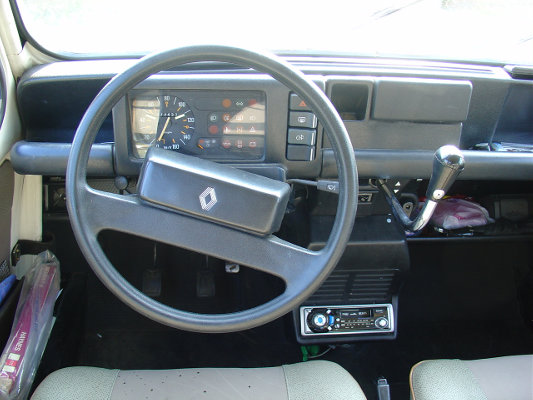
I installed my hi-tech 'media centre' from Reflexia. This exuberantly labelled device basically consists of Renault's standard plastic audio mounting, housing my hideous but functioning cassette radio, bought for only £15 new and therefore inherently tamper-proof in its undesirability. Alas, unlike all my other Fours to date, there is no aerial mounted on this car's roof, so the radio will not work without further installation efforts. As somebody who grew up just after the golden days of vinyl and prior to the popular acceptance of compact discs, I blossomed in and am a proud member of the cassette tape generation, and my several hundred articles of proof will not be disappearing in a hurry, so this music system of a bygone era suits my needs sufficiently.
One annoying little difference from my previous, older models, is the later windows and frames fitted by Renault. In contrast to the shiny chrome pillars exhibited by Reflexia, those on QG are distinctly rusty and seemingly of inferior quality. But the really ridiculous part is the handle on each window, which instead of securely clasping an additional small piece through a hole drilled in the glass, ensuring reliable long-term operation, is merely stuck on to just one side. The stupidity of this was amply demonstrated whilst I was inside cleaning the seats and needed to slide a rear window open for ventilation. The handle flew off in my hand (perhaps it should be renamed an 'airle'), and will need to be reaffixed. This would appear to represent the most extreme and surely unnecessary of cost-cutting measures applied by Renault in latter years of R4 production. It was agreed - as part of the deal made on the car - that the windows would in future be replaced with nicer ones, and it's really not a big issue, I just can't see why it was really worthwhile for Renault to ever change such minor details for such modest monetary savings.
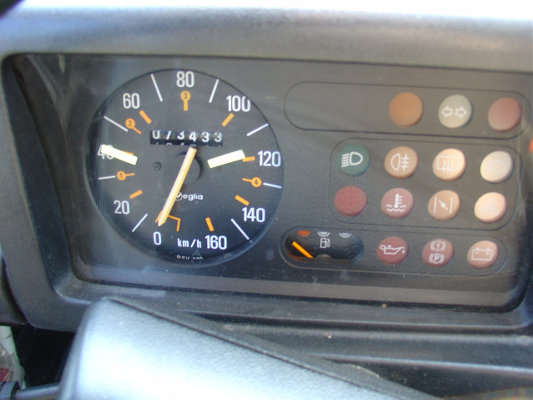
The car has done a relatively low mileage, although the speedo of course displays kilometres - just 73000 of them - which equates to only 45000 miles. This lack of maturity in distance seems apparent from the noticeably smooth ride afforded to passengers. As Derek at Renospeed observed, the lower mileage models tend to not only feel less rough, but also sound less rattly, with few of the squeaks and taps that R4 owners eventually become accustomed to. I stuck a couple of markers on the speedometer glass to remind me where the miles are when in England. Since the twelve o'clock position is occupied by 80km/h, which is 50mph, it's only really necessary to mark the 30mph and 70mph positions, and the remaining limits are then easy enough to figure out.
So, onto the engine, and the attached picture (below) which doesn't offer too many surprises. I should have captured the mechanical layout of at least one of my right-hand drive models in the past, since the majority of R4 fans around the world are more intrigued to see how they differ, but although I suspect I did take a photo of either Angelica's or Nicolexia's motor on that film that never wound on or came out (and which, yes, I am still bitter about almost ten years on), there is no such evidence to be found on this site. Several other UK owners have nonetheless sent images of their engines for display on other pages.
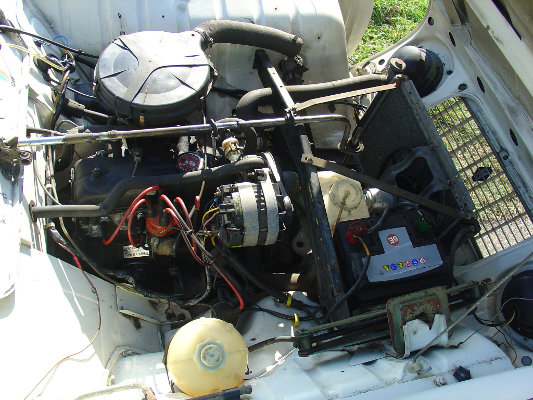
I had initially advised Derek that I was probably not interested in the car due to it being a TL, and therefore equipped with an 850cc engine, which I saw as being not only less powerful but also potentially more troublesome when replacing associated parts in future. In fact, it turns out that it has a capacity I had until now always tended to forget existed on a Renault 4. Based off the more standard 1108cc engine from the GTL, Renault installed a smaller 956cc variant in many markets around the world. Again, these never sold in the UK, which is the reason I always forget about them. Unlike the official '1128' model number that was applicable to all my former GTLs, this type is a '112C'. The engine has a smooth feel but is a little more strained at higher speeds than the GTL, producing a noticeably higher-pitched drone. For that reason, I really don't wish to push the car to its limits so often, like I did frequently in all my past Fours. In fact, I never want to drive in that way but I so often seem to find myself with some time pressures upon me, as noted in my previous adventures, and such requirements are inevitable. I will have to plan future long distance trips with a greater time margin to allow the car some respite.
The processes involved in importing the car to the UK are reasonably straightforward, at least for a vehicle of this age and type. Things get considerably more hairy if the vehicle's age is under 10 years, but of course that shall never now apply to a Renault 4. A rather complicated-looking form provided by the DVLA and seemingly not revised in decades, in view of the holes punched down the sides for use with long since outmoded daisy wheel printers, contains a bewildering array of questions but most of which are not necessary to be completed by the vehicle owner. A relevant customs form accompanies the application. In theory, a number of adaptations may need to be made to the car, dependant on what legal requirements existed in the UK at the time of manufacture abroad, e.g. rear seatbelt fittings, reverse lights, side indicator lights, etc. Evidence of such modifications is not required by the DVLA in certain scenarios, however. They suggest that they may wish to inspect the car, though I doubt they do this too often. I could not give any authoritative guide to the process since it can vary according to the age and type of Renault 4, and its country of origin.
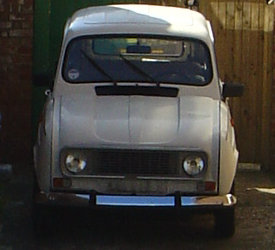
The car first needs to pass the MOT, after which a revised insurance certificate or cover note needs to be issued containing the Vehicle Identification Number (or last six digits thereof) instead of the registration. I was not advised of this in any official literature or online information when I first visited the local DVLA office with all other supporting documentation in hand. Subsequently, when they complained that my current insurance certificate listed my previous car's registration and should show the current one instead, I had some choice words for them in view that I was there for that exact purpose of acquiring the new registration and hence, how the feck could it? They also wouldn't accept my existing certificate on the grounds that it covered me for driving 'any car', insisting it must specifically list the new vehicle. After a wasted afternoon's trip into town I had to wait another week for my insurance company to send out a cover note showing the new details. A week after that, the application was accepted and I received both a tax disc and a number plate authorisation certificate in the post, along with all my returned documents. The cost of this procedure came to £180 (£125 for one year's tax, £55 for them to try and source a daisy wheel printer). After that, the new number plates could be purchased and fitted. The photo above shows the car with nice French black and silver pressed aluminium plates removed, awaiting the comparatively ugly British replacements. A registration appropriate to the year of manufacture is attributed, so in this case the old system in place during 1987 is used, resulting in an E reg plate.
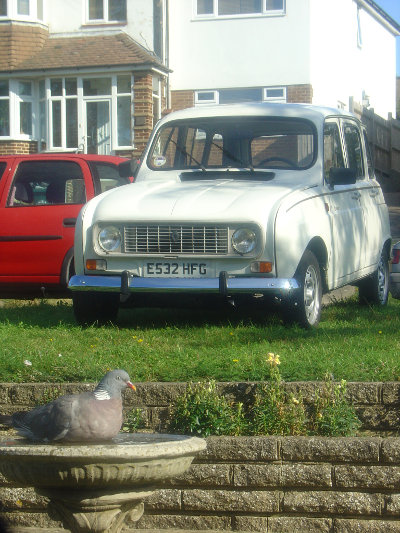
You might wonder why I decided to register the car in Britain if I am intending to spend large parts of my time in the car's original home of France. There were several reasons. A wholesale change is required; all or nothing, in the sense that the registration, tax, insurance and MOT must all be handled in the same country. Had I decided to retain the French registration, the traditional system in place nationally dictates that re-registration is required when the owner moves to another département, and this incurs a fee. Since this system changed and was scrapped relatively recently, I don't know whether the old or new system would apply to a vehicle of this age. The main motivation, however, was the increasing and alarming number of reports that Derek, myself and others have been conscious of in recent times, that the French equivalent of the MOT, the Contrôle Technique, has become overly strict and difficult for owners of older vehicles. Perhaps in an attempt by the French government to kickstart the national automobile industry and keep sales ticking over in a nation where large numbers of the population choose to hold onto cars for considerable time, and so drive around in old bangers, a policy change seems to have been implemented making it exceedingly difficult to get a car through this test if so much as a patch of rust should be evident. Derek reports that owners he knows have had their Fours failed on the most ridiculous and pathetic minor rust problems, even in places where it is surely irrelevant to any issues of mechanical, structural or personal safety. Whilst I still have some connection to the UK, I'm eager to avoid this predicament, although Queen Geanine currently suffers few such ills. The worrying thing is that large numbers of perfectly decent Renault 4s may be being driven off the road due to these new regulations. The French had better start to value the cars more before it's too late.
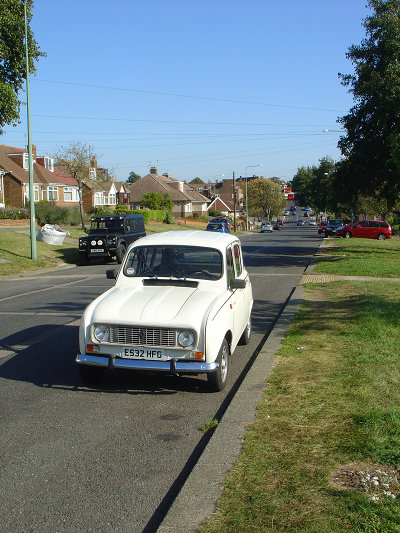
I've probably said enough in this lengthy article, and there should be plenty more opportunities to comment further on the car in future. Another image featuring the posh pigeon seen above can be found on the Pets page in the Playroom (number PE22). Of course, I was obliged to complete another little habitual routine afforded to all previous R4s in the family, by taking a photo of it in the exact same spot as all those others, as seen above.
